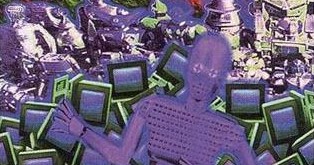
| last update 10.11.2025 21:34 | |||||
|
| Top Runners' Quarterly |
| Frisky's Corner |
| Neal's Last Words |
On Decks
In this article, I'd like to make some general remarks on the role of Decks (as in the type of Hardware Runner cards) in Netrunner. Most of these insights were formulated in a discussion I had with Neal (I think), so credits are partly due to him. Well, talking of Decks, the one burning question must be: Why is almost nobody playing them? There are of course some notable exceptions, like Bodyweight Data Creche and The Deck, but these have some very unique abilities (see Muneki's article below) and are not representative of Decks in general. The basic design concept behind the more typical Decks is the amalgamation of several abilities into one card. Take Raven Microcyb Owl, for example. For 11 bits, an action and a card, you get +1 MU and 3 Stealth bits. This is the same effect as a WuTech Mem Chip and a Cloak would give you. Installing WuTech and Cloak costs only 8 bits, but you have to figure the additional installing action, the additional card and the additional MU (to hold Cloak) into the equation. If an action, a card, and an MU equal 1 bit each (which is cheap for MU), the equation makes sense. Somehow, that is. There is one big design problem with Decks. The designers must have thought that it is a great benefit to have several abilities slipped into one card - after all, it slims your stack down. But this comes at a stiff price. It is always painful for the Runner to invest a lot of bits at one go, because ideally, he or she needs to have some reserves in the pool at all times, in order to be able to threaten a run. Therefore, most of the time, Runners want fast, cheap and focused solutions to their immediate problems. Long-term investments might not yield any returns at all in Netrunner, since the game might always end in the next turn. This is especially true in the cutthroat environment of Constructed tournaments. What this means is that, if Runners need MU, they want a WuTech or an Imp, but not Raven Microcyb Owl. If they need hand size, they want MRAM Chips, not Sunburst Cranial Interface. If they want Stealth bits, they will install Cloaks with Valu-Pak Software Bundle and lots of Zetatech Software Installers, rather than Raven Microcyb Owl. If they want a really good link value for free, they'll install - ok, they'll install The Deck, but you get the idea. Therefore, what the designers envisioned as "versatile" or "lean", with the appropriate pricing policy, turned out to be "unfocused" in the end, and Decks would have to be not more expensive than the individual cards whose abilities they combine, but of the same cost, in order to make them playable. Maybe they should even be cheaper, since Decks have the additional restriction that only one can be in play at any one time. That it didn't work out that way is a pity, since storywise it makes great sense for the Runner to crave the latest Deck technology for that tiny edge on the Corp ice. In the following article, Muneki takes a shot at classifying the various Decks of Netrunner.
|
|
